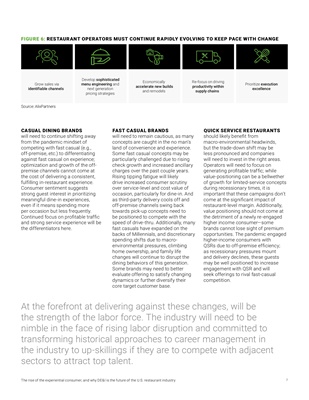
The rise of the experiential consumer, and why DE&I is the future of the U.S. restaurant industry 7
CASUAL DINING BRANDS
will need to continue shifting away
from the pandemic mindset of
competing with fast casual (e.g.,
off-premise, etc.) to differentiating
against fast casual on experience;
optimization and growth of the offpremise
channels cannot come at
the cost of delivering a consistent,
fulfilling in-restaurant experience.
Consumer sentiment suggests
strong guest interest in prioritizing
meaningful dine-in experiences,
even if it means spending more
per occasion but less frequently.
Continued focus on profitable traffic
and strong service experience will be
the differentiators here.
FIGURE 6: RESTAURANT OPERATORS MUST CONTINUE RAPIDLY EVOLVING TO KEEP PACE WITH CHANGE
Grow sales via
identifiable channels
Re-focus on driving
productivity within
supply chains
Develop sophisticated
menu engineering and
next generation
pricing strategies
Economically
accelerate new builds
and remodels
Prioritize execution
excellence
Source: AlixPartners
FAST CASUAL BRANDS
will need to remain cautious, as many
concepts are caught in the no man's
land of convenience and experience.
Some fast casual concepts may be
particularly challenged due to rising
check growth and increased ancillary
charges over the past couple years.
Rising tipping fatigue will likely
drive increased consumer scrutiny
over service-level and cost value of
occasion, particularly for dine-in. And
as third-party delivery cools off and
off-premise channels swing back
towards pick-up concepts need to
be positioned to compete with the
speed of drive-thru. Additionally, many
fast casuals have expanded on the
backs of Millennials, and discretionary
spending shifts due to macroenvironmental
pressures, climbing
home ownership, and family life
changes will continue to disrupt the
dining behaviors of this generation.
Some brands may need to better
evaluate offering to satisfy changing
dynamics or further diversify their
core target customer base.
QUICK SERVICE RESTAURANTS
should likely benefit from
macro-environmental headwinds,
but the trade-down shift may be
less pronounced and companies
will need to invest in the right areas.
Operators will need to focus on
generating profitable traffic; while
value-positioning can be a bellwether
of growth for limited-service concepts
during recessionary times, it is
important that these campaigns don't
come at the significant impact of
restaurant-level margin. Additionally,
value positioning should not come at
the detriment of a newly re-engaged
higher income consumer-some
brands cannot lose sight of premium
opportunities. The pandemic engaged
higher-income consumers with
QSRs due to off-premise efficiency;
as recessionary pressures mount
and delivery declines, these guests
may be well positioned to increase
engagement with QSR and will
seek offerings to rival fast-casual
competition.
At the forefront at delivering against these changes, will be
the strength of the labor force. The industry will need to be
nimble in the face of rising labor disruption and committed to
transforming historical approaches to career management in
the industry to up-skillings if they are to compete with adjacent
sectors to attract top talent.